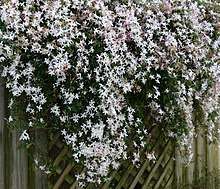Mullaippāṭṭu
Mullaippāṭṭu (Tamil: முல்லைப்பாட்டு, lit. "the forest or jungle song") is an ancient Tamil poem in the Sangam literature.[1] Authored by Napputanar, it is the shortest poem in the Pattuppāṭṭu anthology, consisting of 103 lines in akaval meter.[2][3] It is largely an akam-genre (love) poem about a wife in grief when her husband does not return from the war front, when he promised he will. The Mullaippattu weaves her sorrow with her attempts at patience and self-control. The poem was likely composed about 230 CE or slightly later, according to Kamil Zvelebil – a Tamil literature scholar.[2][4]

The title of the poem Mullaippattu refers to the creeper mullai (jasmine) that carries sweet-smelling flowers in the jungles of South India, states Chelliah.[3] It metonymically connotes the jungle home and sweet wife a warrior chieftain left when he went on his military campaign. He promised to return before the rains.[5] The rains have come, are falling abundantly, but neither has her husband returned nor a word about him has come. She is worried and in grief. She and her maids pray in a temple for his return, make offerings.[5] They seek omens and words of guess. She tries to be patient but can hide her sorrow. The poem alternates lines painting her in her cycles of emotions. Then, she hears the trumpeting approach of victorious troupes, signaling the return of her husband. She is filled with joy.[5]
The poem is "one of the most beautiful of the Pattuppattu songs, states Zvelebil.[4] The akam portions of the poem paint the lover's anguish, while the puram portions describe the temporary military camp of the chieftain in the jungle.[4][3] The chieftain is reflecting on the loss of life, the injured soldiers and the crippled elephants in previous military campaigns.[4][3] His wife is worried about him.[3] The two portions – akam and puram – are woven together in the form of a mattu (linking) for a contrasting impact.[4][3] The 14th-century scholar Naccinarkkiniyar wrote a commentary on this poem.[4]
The Mullaippattu is a source of historical and social information. It is notable for its mention of yavanas (Greek-Romans, lines 61, 73–83) as part of the troupes in the Tamil kingdom's army.[2][6] It describes their dress, uses the word mileccar for them, and calls them the bodyguard of the king. The yavanas can't speak the local language and communicate using gestures, states Mullaippattu.[2][7] The mahouts (riders) of the elephants are described as "speaking the northern language".[2] The military camp is described as camouflaged, tents covered with leaves, and the entire camp surrounded by thorny cover.[8] The poem mentions water clock, different variety of flowers in the jungle, and warriors going into battle wearing a garland of flowers.[7]
The short poem mentions the Hindu god Vishnu through an elaborate simile.[9][10][11] It also mentions the goddess of wealth, Lakshmi in lines 6–7, to whom the women pray for the return of the warriors.[12][13] Lines 46–47 of Mullaippattu mentions Brahmin yogis in ochre-colored clothes carrying three staves.[14] The poem has about 500 words, predominantly Tamil. It has 13 Sanskrit loan words and 2 non-Tamil provincial words.[15]
See also
References
- Kamil Zvelebil 1974, pp. 25–26.
- Kamil Zvelebil 1973, p. 61.
- JV Chelliah 1946, pp. 81–84.
- Kamil Zvelebil 1974, p. 25.
- JV Chelliah 1946, pp. 81–82.
- G. John Samuel (1977). Studies in Comparative Literature: Tamil, Malayalam & English. Mani Pathippakam. p. 92.
- JV Chelliah 1946, pp. 83–84.
- JV Chelliah 1946, pp. 82–84.
- JV Chelliah 1946, pp. 84, 90, 94.
- S. R. Balasubrahmanyam (1966). Early Chola Art. Asia Publishers. p. 5.
- Hephzibah Jesudasan; G. John Samuel; P. Thiagarajan (1999). Count-down from Solomon, Or, The Tamils Down the Ages Through Their Literature: Caṅkam and the aftermath. Institute of Asian Studies. p. 44.
- JV Chelliah 1946, pp. 84, 94.
- K. V. Raman (2006). Temple Art, Icons And Culture Of India And South-East Asia. Munshiram Manoharlal. pp. 141, 151 note 3. ISBN 978-81-88934-31-7.
- JV Chelliah 1946, pp. 84, 91, 94.
- JV Chelliah 1946, pp. 85.
Bibliography
- JV Chelliah (1946). Pattupattu - Ten Tamil Idylls (Tamil Verses with Englilsh Translation). Tamil University (1985 print).CS1 maint: ref=harv (link)
- Edward Jewitt Robinson (2001). Tamil Wisdom: Traditions Concerning Hindu Sages and Selections from Their Writings. New Delhi: Asian Educational Services.
- Mudaliyar, Singaravelu A., Apithana Cintamani, An encyclopaedia of Tamil Literature, (1931) - Reprinted by Asian Educational Services, New Delhi (1983)
- Pillai, M. S. Purnalingam (1994). Tamil Literature. Asian Educational Services. p. 115. ISBN 81-206-0955-7.
- Ray, Himanshu Prabha (2003). The archaeology of seafaring in ancient South Asia. Cambridge: Press Syndicate of the University of Cambridge. ISBN 9780521011099.
- Selby, Martha Ann (2011) Tamil Love Poetry: The Five Hundred Short Poems of the Aiṅkuṟunūṟu, an Early Third-Century Anthology. Columbia University Press, ISBN 9780231150651
- Takanobu Takahashi (1995). Tamil Love Poetry and Poetics. BRILL Academic. ISBN 90-04-10042-3.
- Eva Maria Wilden (2014). Manuscript, Print and Memory: Relics of the Cankam in Tamilnadu. Walter de Gruyter. ISBN 978-3-11-035276-4.
- Kamil Zvelebil (1973). The Smile of Murugan: On Tamil Literature of South India. BRILL. ISBN 90-04-03591-5.CS1 maint: ref=harv (link)
- Kamil Zvelebil (1974). Tamil Literature. Otto Harrassowitz Verlag. ISBN 978-3-447-01582-0.CS1 maint: ref=harv (link)
- Zvelebil, Kamil (1992). Companion studies to the history of Tamil literature. BRILL. p. 73. ISBN 90-04-09365-6.